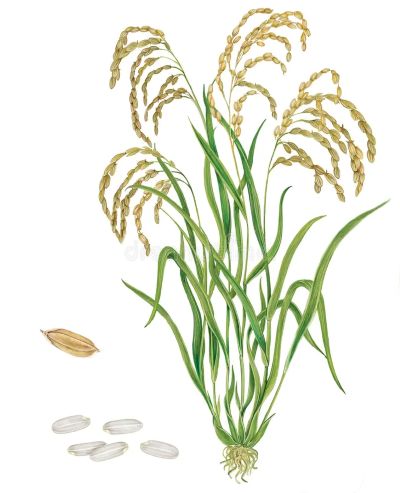Cultivated Rice
Cultivated Rice
Oryza sativa L.
Family Poaceae
Description of Rice
Cultivated rice is an annual herbaceous plant, 50–150 cm tall, with an erect stem and narrow linear leaves (20–50 cm). The flowers are small, greenish-white, gathered in paniculate inflorescences (15–30 cm). The fruits are caryopses, 5–10 mm, white, brown, or red, covered with hulls. Varieties: 'Basmati', 'Jasmine', 'Arborio', 'Sushi Rice', 'Wild Rice' (though botanically a different genus, Zizania aquatica), 'Black Rice', 'Brown Rice'. Flowering occurs in June–August, fruiting in August–October.
Habitat and Ecology of Rice
The homeland of rice is Southeast Asia. It grows in tropical and subtropical zones of Asia, Africa, America, and Australia, in flooded fields, up to 1000 m above sea level. It is cultivated in China, India, Thailand, and Russia (Krasnodar Krai). It prefers clayey, fertile soils (pH 5.5–7.0), flooded with water (10–20 cm), and requires watering with 50–100 l/m² per season. It reproduces by seeds. Yield: 4–8 t/ha. Care includes weeding, fertilizing with nitrogen (20–30 g/m²), and protection from rice weevils and fungal diseases. It is used for soil strengthening and ornamental purposes.
Rice Raw Material
Raw materials: grains (fructus Oryzae), bran (farina Oryzae), leaves (folia Oryzae). Grains are harvested in August–October, dried at 40–50 °C (yield 60–70% after processing). Bran is obtained during milling, dried at 30–40 °C (yield 10–15%). Leaves are harvested in July–August, dried at 40 °C (yield 15–20%). Quality: grains — free from mold, white or brown; bran — light brown; leaves — green; moisture ≤12%. Store in airtight containers (grains: 2 years; bran: 6 months; leaves: 1 year). The smell is neutral, the taste is mild (grains), slightly bitter (bran).
Chemical Composition of Rice
Grains: carbohydrates (up to 75%), proteins (up to 8%), fiber (up to 3%), vitamins B1, B2, B6, E, minerals (Mg, K, P). Bran: fiber (up to 20%), fatty oils (up to 15%), vitamin E, antioxidants (ferulic acid). Leaves: flavonoids, tannins (up to 2%), vitamin C (up to 20 mg%). Caloric content of grains: 300–350 kcal/100 g (polished), 350–400 kcal/100 g (unpolished).
Action and Application of Rice
Rice has nourishing, astringent, enveloping, and anti-inflammatory effects. It is used for diarrhea, gastritis, stomach ulcers, anemia, and skin irritations. Grains improve digestion, normalize intestinal microflora, and strengthen bones. Bran lowers cholesterol and supports skin health. Leaves are used for throat inflammation and wound healing. Rice decoction is effective for intoxication and fever.
Precautions for Rice Use
Consumption of >500 g/day of polished rice can cause constipation and hypoglycemia. Store decoction at 0–5 °C for no longer than 24 hours. For children under 1 year, give ≤50 g/day of porridge. Avoid excessive consumption of bran (>50 g/day) due to the risk of intestinal irritation. Long-term use of leaf infusions (>2 weeks) requires medical supervision. Rinse grains thoroughly due to pesticides.
Contraindications for Rice Use
Allergy to Poaceae, chronic constipation, diabetes mellitus (for polished rice), exacerbation of intestinal ulcer, age under 1 year.
Rice Recipes
- Grain Decoction for Diarrhea. Boil 50 g of rice in 500 ml of water for 20 minutes, drink 100 ml 3 times a day for 3 days.
- Leaf Infusion for Throat Inflammation. Pour 200 ml of boiling water over 10 g of leaves, infuse for 20 minutes, gargle 2 times a day for 5 days.
- Bran Mask for Skin. Mix 20 g of bran with 10 ml of water, apply for 15 minutes, rinse, twice a week.
- Porridge for Gastritis. Boil 50 g of rice in 300 ml of water for 15 minutes, eat 100 g twice a day for 7 days.
- Rice Water for Upset Stomach. Boil 1 cup of rice in 4 cups of water until the rice is very soft. Strain and drink the liquid to soothe an upset stomach or diarrhea.
Rice Cosmetics
Rice is used for skin care.
- Whitening Mask. 20 g of rice flour, 10 ml of milk, apply for 15 minutes, rinse, twice a week.
- Face Scrub. 20 g of bran, 10 ml of honey, massage skin for 5 minutes, rinse, once a week.
- Moisturizing Lotion. 20 ml of rice decoction, 10 ml of water, wipe skin, once a day.
- Mask for Oily Skin. 20 g of rice flour, 10 ml of yogurt, apply for 15 minutes, rinse, twice a week.
- Rice Hair Rinse. Ferment rice water for 1-2 days, then use as a hair rinse after shampooing to promote shine and strength.
Rice Culinary Uses
Grains are used in dishes and beverages.
- Rice Porridge. 100 g of rice, 300 ml of water or milk, boil for 15–20 minutes.
- Pilaf. 200 g of rice, 100 g of meat, 50 g of carrots, 50 g of onions, cook for 40 minutes.
- Rice Soup. 50 g of rice, 500 ml of broth, 50 g of vegetables, cook for 20 minutes.
- Bran Drink. Pour 200 ml of water over 20 g of bran, infuse for 30 minutes, strain.
- Sushi. Prepare vinegared sushi rice and combine with fresh fish, vegetables, and nori.
- Rice Pudding. Cook rice with milk, sugar, and spices like cinnamon or vanilla until creamy. Serve warm or cold.
- Risotto. A creamy Italian rice dish made with Arborio rice, broth, Parmesan cheese, and various other ingredients.
- Stir-fried Rice. Cooked rice stir-fried with vegetables, egg, and soy sauce, often with added protein.
Tips: Store grains at 0–25 °C for up to 2 years, bran for up to 6 months. Rinse rice before cooking.
Other Properties of Rice
Used in ornamental landscaping, for soil strengthening, and as a fodder crop.




